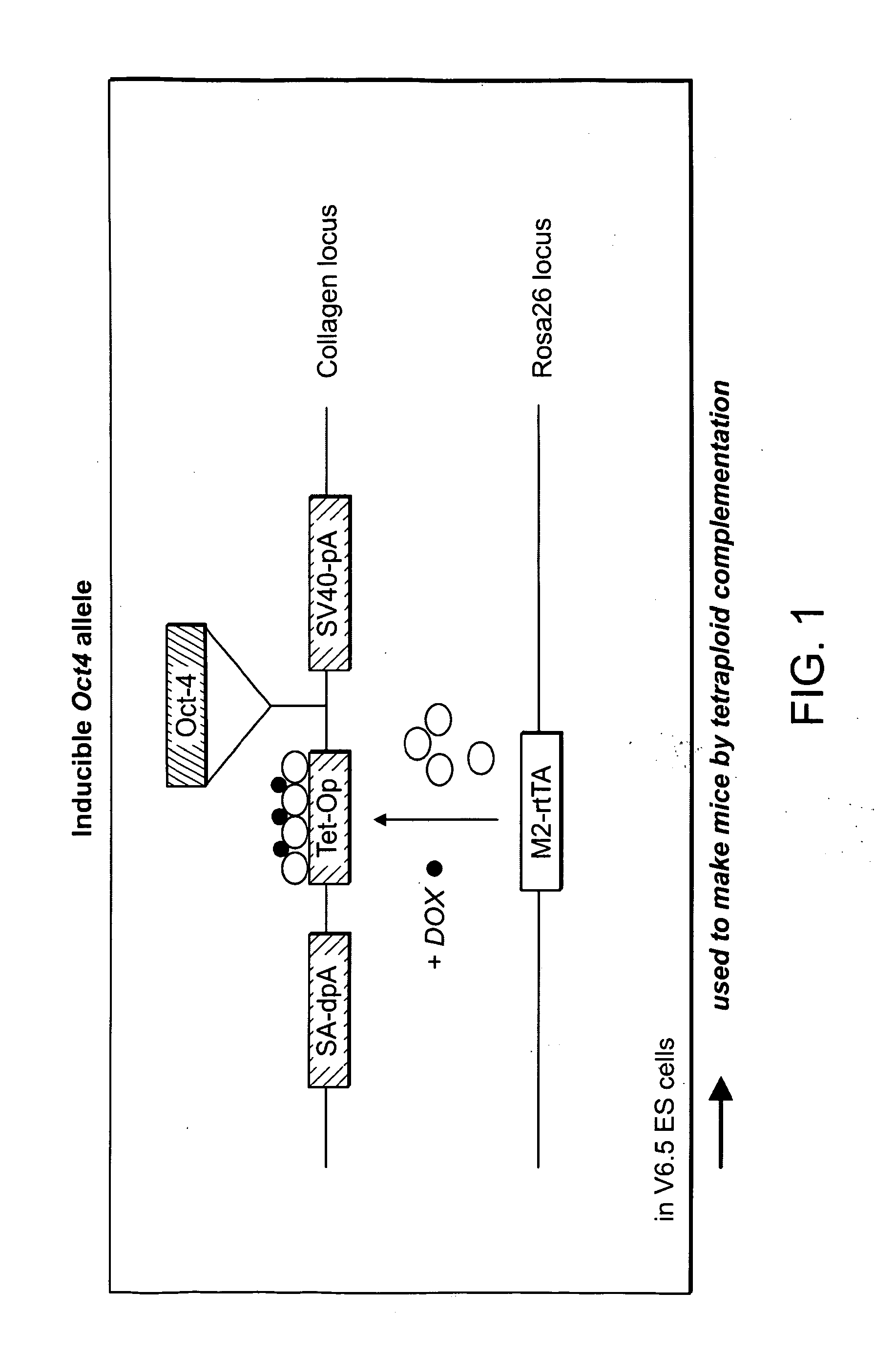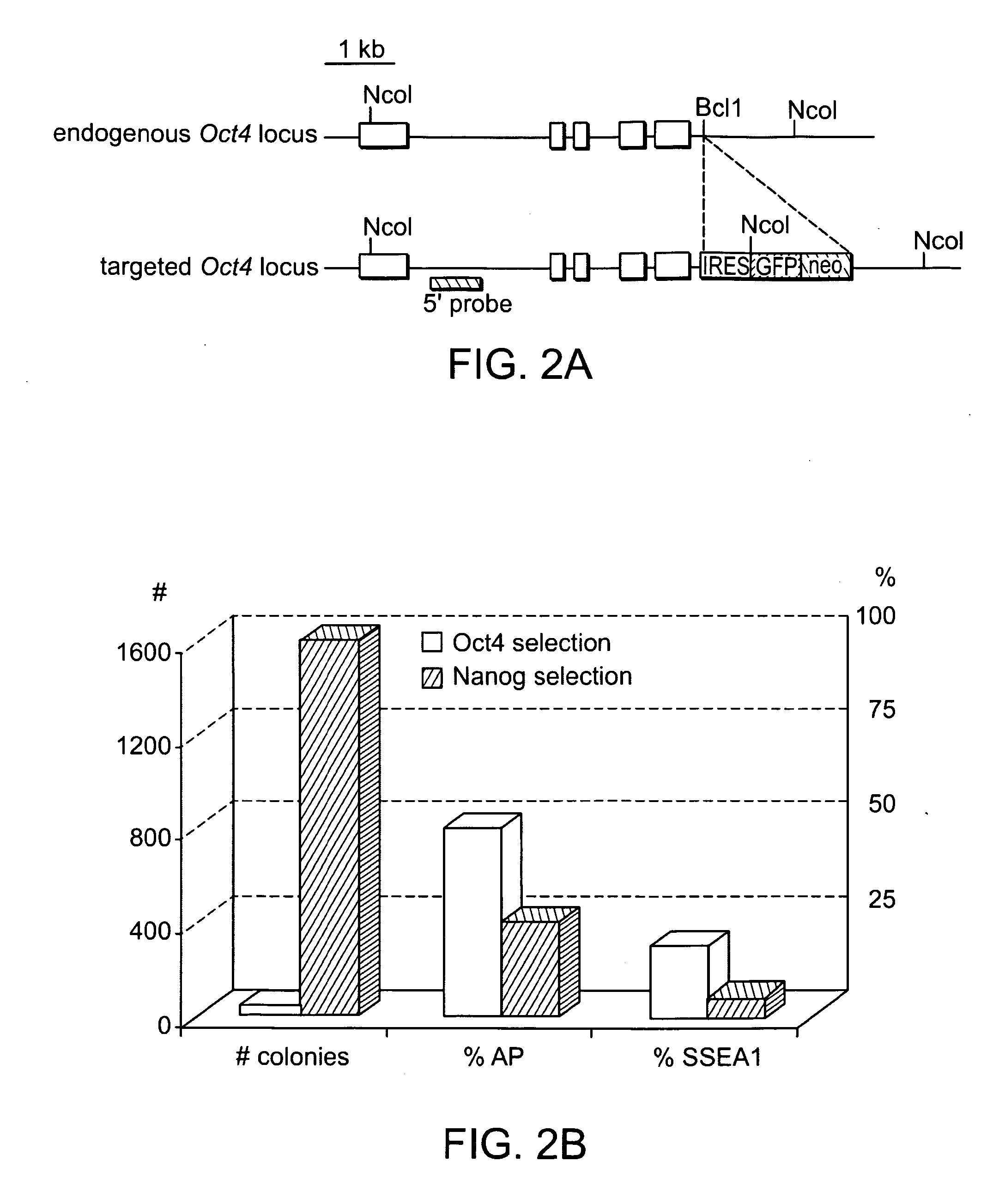Reprogramming of somatic cells
- Summary
- Abstract
- Description
- Claims
- Application Information
AI Technical Summary
Benefits of technology
Problems solved by technology
Method used
Image
Examples
example 1
Methods
Cell Culture, MEF Isolation and Viral Infections
ES and iPS cells were cultivated on irradiated MEFs in DME containing 15% fetal calf serum, Leukemia Inhibiting Factor (LIF), penicillin / streptomycin, L-glutamine, and non-essential amino acids. All cells were depleted of feeder cells for two passages on 0.2% gelatin before RNA, DNA or protein isolation. Transgenic MEFs were isolated and selected in 2 μg / ml puromycin (Sigma) from E13.5 chimeric embryos following blastocyst injection of Oct4-inducible KH2 ES cells (Hochedlinger et al., Cell 121(3):465 (2005)) which had been previously targeted with either Oct4-IRES-GfpNeo or Nanog-neo constructs (Mitsui et al., Cell 113(5):631 (2003)). 2×105 MEFs at passage 3-4 were infected overnight with pooled viral supernatant generated by transfection of HEK293T cells (Fugene, Roche) with the Moloney-based retroviral vector pLIB (Clontech) containing the cDNAs of Oct4, Sox2, Klf4 and c-Myc together with the packaging plasmid pCL-Eco (Naviaux...
example 2
Methods
Cell Culture, MEF Isolation and Viral Infections
ES and iPS cells were cultivated on irradiated MEFs in DME containing 15% fetal calf serum, Leukemia Inhibiting Factor (LIF), penicillin / streptomycin, L-glutamine, beta-mercaptoethanol and non-essential amino acids. All cells were depleted of feeder cells for two passages on 0.2% gelatin before RNA, DNA or protein isolation. 2×105 MEFs at passage 3-4 were infected overnight with pooled viral supernatant generated by transfection of HEK293T cells (Fugene, Roche) with the Moloney-based retroviral vector pLIB (Clontech) containing the cDNAs of Oct4, Sox2, Klf4 and c-Myc together with the packaging plasmid pCL-Eco (Naviaux et al., J Virol 70:5701 (1996)).
Blastocyst Injection
Diploid or tetraploid blastocysts (94-98 hours post HCG injection) were placed in a drop of DMEM with 15% FCS under mineral oil. A flat tip microinjection pipette with an internal diameter of 12-15 mm was used for ES cell injection. A controlled number of ES cell...
example 3
Methods
Cell Culture and Viral Infections.
ES and established iPS cells were cultured on irradiated MEFs in DME containing 15% FCS, leukemia inhibiting factor (LIF), penicillin / streptomycin, L-glutamine, beta-mercaptoethanol and nonessential amino acids. MEFs used to derive primary iPS lines by infections with inducible lentiviruses were harvested at 13.5dpc from F1 matings between ROSA26-M2rtTA mice (Beard et al., 2006) and Nanog-GFP mice (Brambrink et al., 2008). Mouse C / EBPα cDNA was cloned into EcoRI cloning site of pLib, MSCV-Neo and pMig retroviral vectors. pMXs vectors encoding ES pluripotency genes were previously described (Takahashi and Yamanaka, 2006). Lentiviral preparation and infection with Doxycycline-inducible lentiviruses encoding Oct4, Klf4, c-Myc and Sox2 cDNA driven by the TetO / CMV promoter were previously described (Brambrink, 2008). Retrovirus stocks were prepared by transient transfection of Phoenix-Eco cells using Fugene (Roche), and supernatants were harvested...
PUM
| Property | Measurement | Unit |
|---|---|---|
| Fraction | aaaaa | aaaaa |
| Electrical resistance | aaaaa | aaaaa |
Abstract
Description
Claims
Application Information
 Login to View More
Login to View More - R&D
- Intellectual Property
- Life Sciences
- Materials
- Tech Scout
- Unparalleled Data Quality
- Higher Quality Content
- 60% Fewer Hallucinations
Browse by: Latest US Patents, China's latest patents, Technical Efficacy Thesaurus, Application Domain, Technology Topic, Popular Technical Reports.
© 2025 PatSnap. All rights reserved.Legal|Privacy policy|Modern Slavery Act Transparency Statement|Sitemap|About US| Contact US: help@patsnap.com



